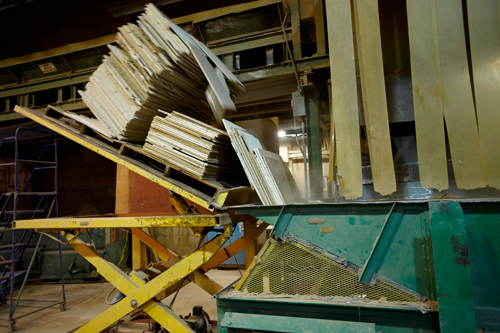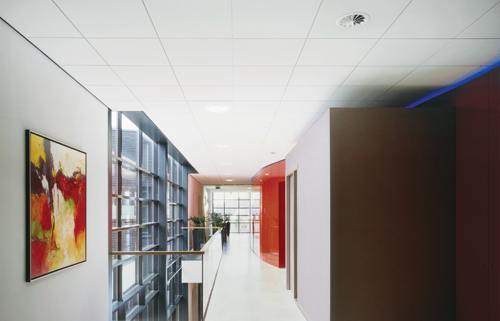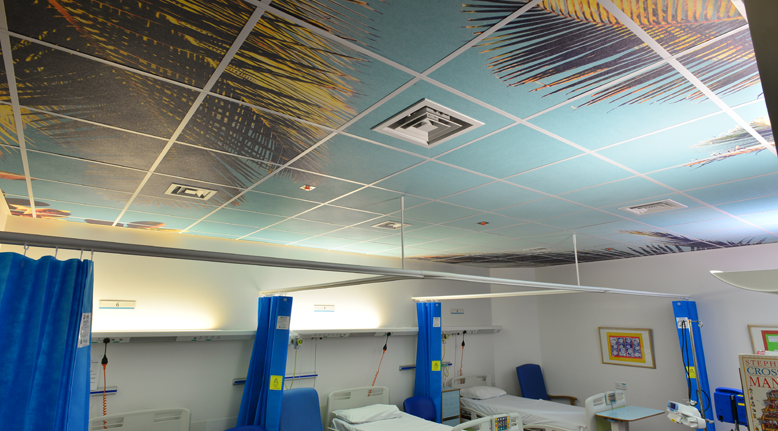Constructing efficiency from above
With six billion people estimated to be living in cities by 2050, how can ceilings help accommodate such growth? Ian Clarke, commercial technical manager for Armstrong Ceiling Solutions, discusses.
The construction industry is at a critical juncture. Headcounts worldwide are growing, and growing fast – and the projected numbers are staggering. It’s predicted there will be nine billion people worldwide by 2050, with two out of every three living in cities by the same date. For those tasked with designing and building our cities, the challenges of such accelerated growth quickly add up. From skills shortages and needlessly complicated supply chains to a fear of embracing BIM, it’s never been more important to face the challenge head on.
But what can be done today to help counter the increased building demand of tomorrow? Simply put, a drive towards greater construction efficiency. To this end, any opportunity for increased simplicity and proficiency should be welcomed. While the building envelope is an obvious focus for building faster and more effectively, the internal space should not be overlooked.
Start how you mean to go on
While the outside of a building goes a long way to define architectural appeal, it’s the interior space which creates comfort and usability. By enhancing light and acoustics, ceilings are a critical aspect of this process, and they are an area where architects, specifiers and installers all stand to benefit from enhanced methodologies.
Involving ceiling manufacturers at the beginning of the design and specification stage is critical. In doing so, a more collaborative, transparent working environment is established where questions from all parties are openly asked and existing conventions are challenged. The result is that key concerns are raised earlier, leading to less rework down the line. A team that’s working together clearly and cohesively also works more efficiently, which will become increasingly important as demand and population figures continue to rise.
On call with one call
In our always-on world, everyone expects to be able to get what they want with a single tap, click or call. The ceiling industry is no different. It’s why, at Armstrong Ceiling Solutions, we provide everything from industry-leading products and expert support right through to training. For example, in the UK 90% of Armstrong products are available next day, while a 24-hour call-to-site service is also available. This approach aids efficiency by greatly simplifying supply chains and, in turn, minimising exposure to unforeseen delays.
Working the right way, right away
Increasingly, contractors are being asked to take on greater responsibility and become jacks of all construction trades. This is leading to increased levels of superficial knowledge and a move to hiring generalists over specialists. While some short-term benefits may exist, the long-term inefficiencies in moving away from specialist expertise are likely to cause serious issues in terms of meeting demand and maintaining quality standards.
By realising this, we’ve made it a clear mission at Armstrong Ceiling Solutions to maintain specialisation and in-depth knowledge in contractors’ skillsets, combining comprehensive training at the renowned Armstrong Installation School, technical support from our ceiling specialists and – in the UK – the Omega Contractor programme of Armstrong recognised specialist ceiling installers. As a result, contractors are able to draw on both their experience and comprehensive, targeted expertise in order to deliver best practice in terms of cost and construction efficiencies.

Win with BIM
The digital age is playing an ever-increasing role in all aspects of construction, meaning a meticulous attention to data is no longer a need, but a must. And Building Information Modelling (BIM) is set to play an ever more prominent role in terms of delivering ceiling construction efficiency.
The benefits of BIM are manifold, not least in terms of improving collaboration and enhancing decision-making. It also greatly reduces rework and eliminates costly duplication of drawings, freeing up talent and capital to be used elsewhere. Yet many within the industry are still not yet fully equipped to deal with BIM, preferring instead to rely on time-proven methodologies. But with just 30 years before we reach the estimated worldwide populace of nine billion, it’s way past time for the industry at large to embrace future-facing technologies and techniques; to look proactively at methods that will enable all of us to construct a more efficient future for all.
Building efficiency into products
While service and support help increase project efficiency, it’s important also to consider the role of the products themselves – in terms of both ease of installation and environmental sustainability. In both cases, Armstrong Ceiling Solutions builds efficiency into its portfolio.
To complement our world-leading range of tiles, we’ve developed a range of highly engineered products – including grids and canopy kits – which simplify installation and maintenance, helping minimise time on site and accelerating project completion.
Last but not least, there’s the efficiency in the products themselves. Currently, some 60% of all materials are used in creating and maintaining our built environment – with a significant amount enduing their service life in landfill. Products which can be recycled and re-used therefore add value to the process as well as to our planet. Among Armstrong Ceiling Solution’s range are a number of products certified as ‘Cradle to Cradle’ (C2C), which means they’re responsibly manufactured and endlessly re-usable. Already a requirement for certain projects in the United States and Europe, C2C is sure to become more widespread, helping contractors provide transparency and protecting our environment for future generations.
To learn more about how Armstrong Ceiling Solutions can help you construct a more efficient future, visit www.armstrongceilingsolutions.co.uk.

















Leave a Reply
Want to join the discussion?Feel free to contribute!